Artisan Sourdough Pumpkin and Pecan Bread
This post may contain affiliate links. As an Amazon Associate, I may receive a small commission, at no cost to you, if you make a purchase. Please read our disclosure policy.
This artisan sourdough pumpkin and pecan bread is full of fall flavors and sure to please the pumpkin spice lover in you! Filled with swirls of cinnamon and nutmeg with plenty of crunchy pecans, this sourdough bread is full of pumpkin flavor.
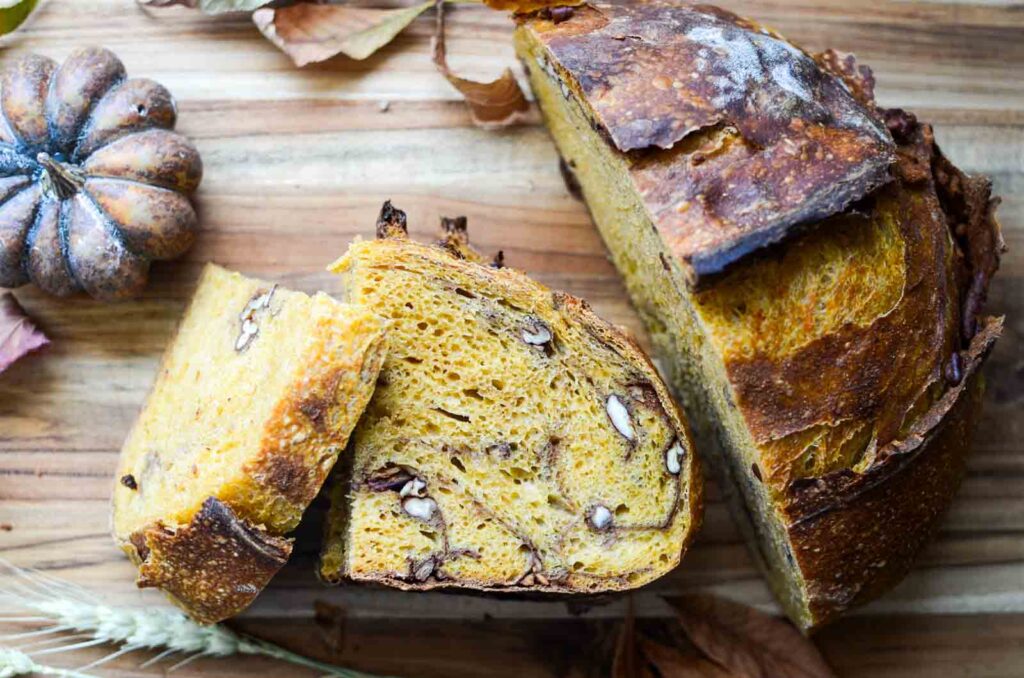
Pumpkin season has arrived at our home. I just harvested pumpkins from the garden today and I’m so excited to make all things pumpkin! Over the years I have used my own pumpkin puree to make sourdough pumpkin scones, sourdough pumpkin bagels, and my husband’s favorite, pumpkin pie. The whole process is so much fun for me! Plus, there’s the bonus of so many pumpkin seeds to roast and snack on.
I love that sourdough pumpkin bread is simple enough to enjoy a slice toasted with a hot cup of coffee on a cold, fall morning, and yet, stunning enough to serve at your Thanksgiving table. Regardless of when you enjoy this bread, I know for certain that you’ll want to make this pumpkin bread on repeat!
Whether you make your own or use canned pumpkin puree, be sure to add making this artisan bread to your fall routine as I’m sure it will quickly become a fall favorite in your home.
Artisan Sourdough Pumpkin and Pecan Bread Ingredients
I’m always amazed that with just a few simple pantry ingredients and spices, adding a bit of sourdough starter and patience produces a lovely, hearty loaf of bread.
Wet Ingredients
- Sourdough starter – This bread relies on the yeast in an active starter for its rise. Use an active sourdough starter that has been fed recently with flour and water and allowed to come to its peak before mixing into the pumpkin bread dough. You’ll know the bubbly starter is ready when it’s grown up the side of the jar
- Pumpkin – Use homemade pumpkin puree or store-bought pumpkin purée to give the bread that pumpkin flavor and added moisture. Pumpkin puree contains only cooked pumpkin and is different than pumpkin pie filling, which comes already sweetened and full of spices.
- Water – Always use warm water, especially during cooler months. This gives the dough a warmer starting temperature, so your bulk fermentation has a head start.
- Maple syrup – Adds sweetness and additional moisture for consistent dough ratios.
Dry Ingredients
- Flour – I suggest using a strong white bread flour because of its higher protein content compared to all-purpose flour. A higher level of protein means stronger flour. Stronger flour means better gluten development, which ultimately yields a higher rise in the final bake.
- Cinnamon and Nutmeg – Seasons the bread with traditional fall flavors.
- Salt – Ensures a well-seasoned bread, full of flavor. But that’s not all, the salt helps tighten the gluten strands which hold the carbon dioxide more efficiently.
- Pecans – Gives the loaf of bread added crunch for great texture.
How To Make Pumpkin and Pecan Sourdough Bread
Mix The Dough
Combine 125 g (1/2 cup) active sourdough starter, 250 g (2 1/4 cups) pumpkin puree, 150 g (2/3 cup) warm water, and 40 g (2 tbsp) maple syrup in a large bowl.
Then, add 500 g (4 cups) bread flour and combine it with a dough whisk. Make sure to mix the flour at the bottom of the bowl. Cover and let rest for 30 minutes. This allows the flour time to absorb the water.
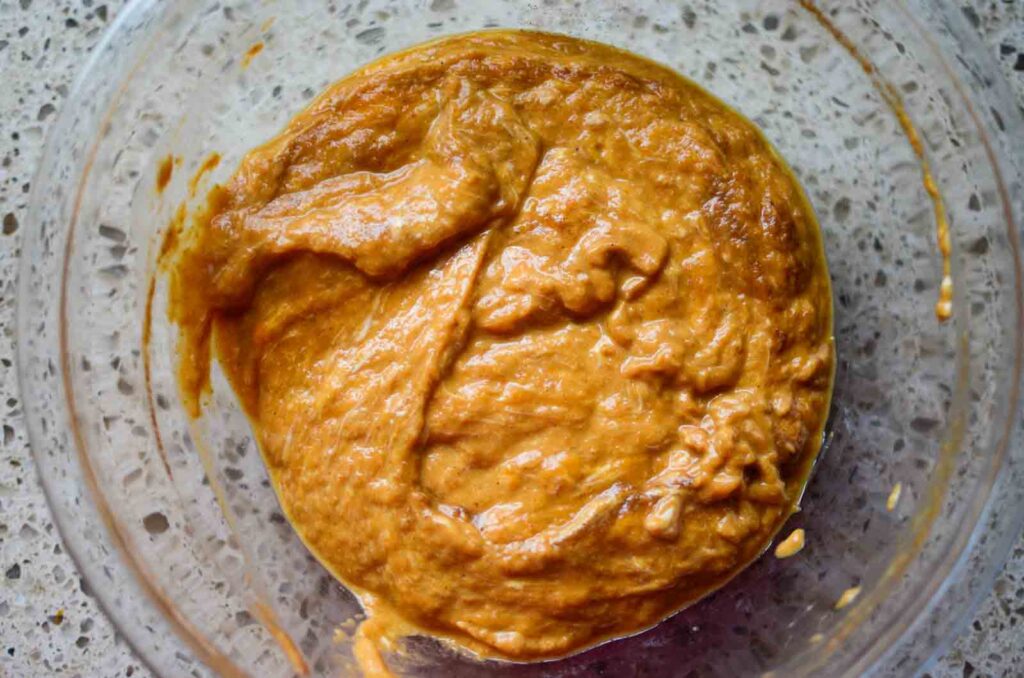
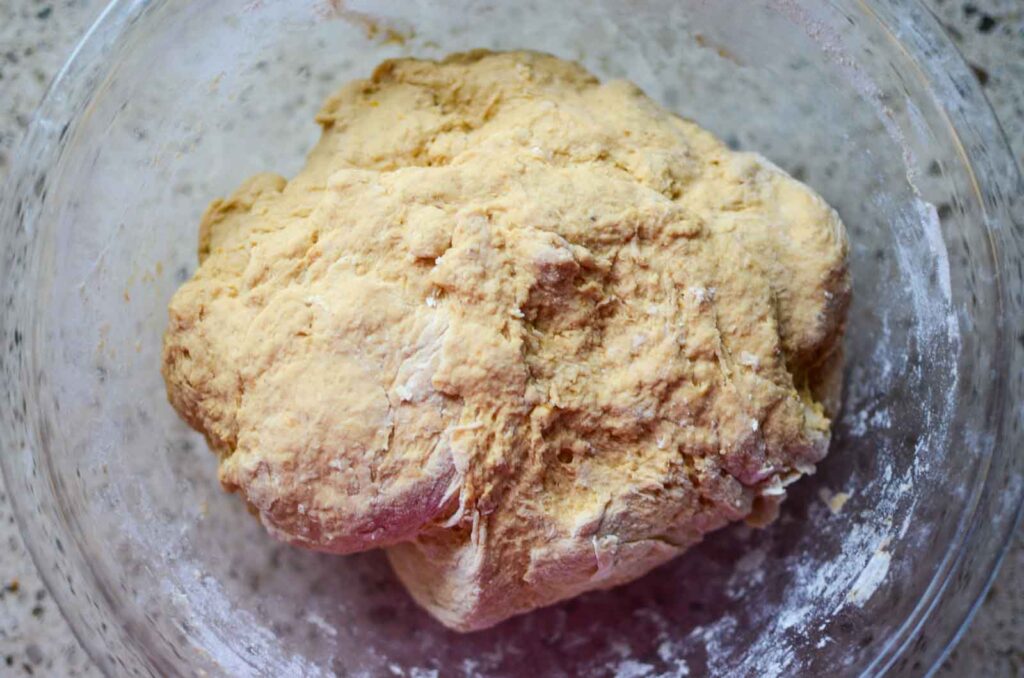
After 30 minutes, combine 36 g (3 tbsp) water and 10 g (2 tsp) salt in a small bowl, stirring until the salt dissolves. Pour the salty water over the bread dough and mix it in using the stretch and folds method.
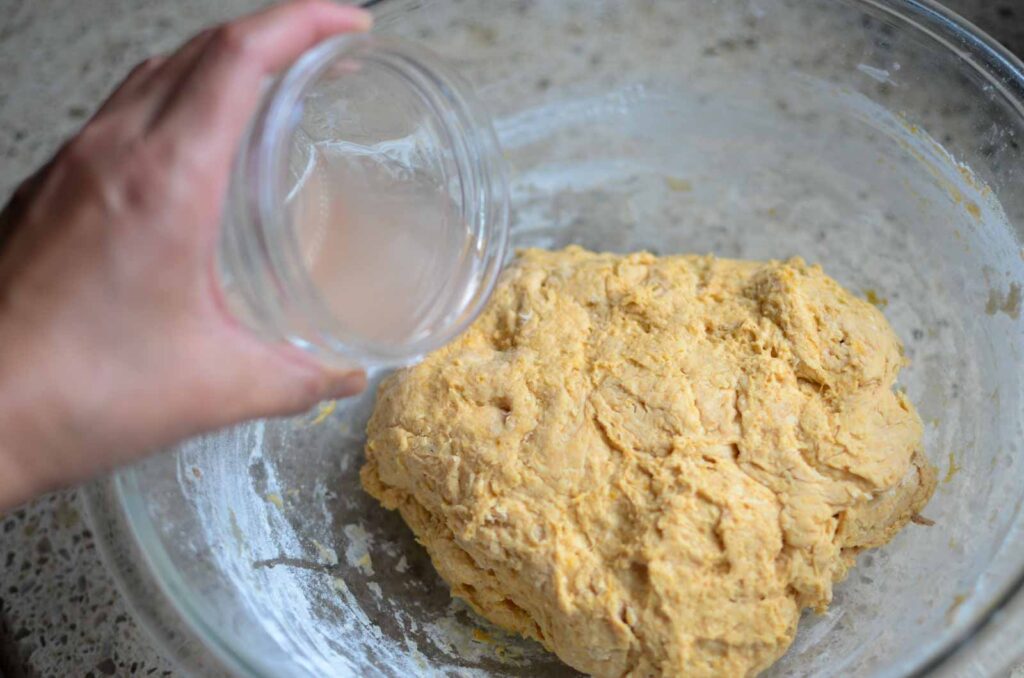
Stretch And Folds
Grab the sides of the dough and lift straight up, stretching the dough. Then fold it over onto itself, pressing it into the middle of the dough.
Let the dough rest for 30 minutes. This completes one set of stretch and folds.
Do a total of 3 sets of stretch and folds at 30-minute intervals. You’ll notice the dough change from a shaggy, sticky dough that breaks easily as you stretch it, to a smooth, elastic dough with much less stickiness by the last fold.
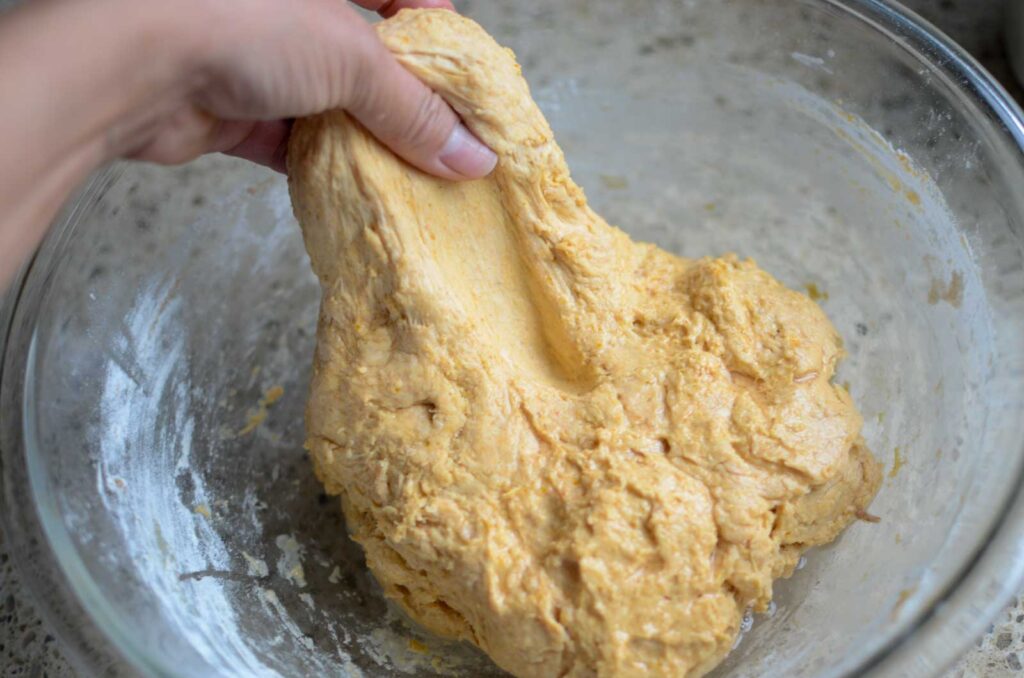
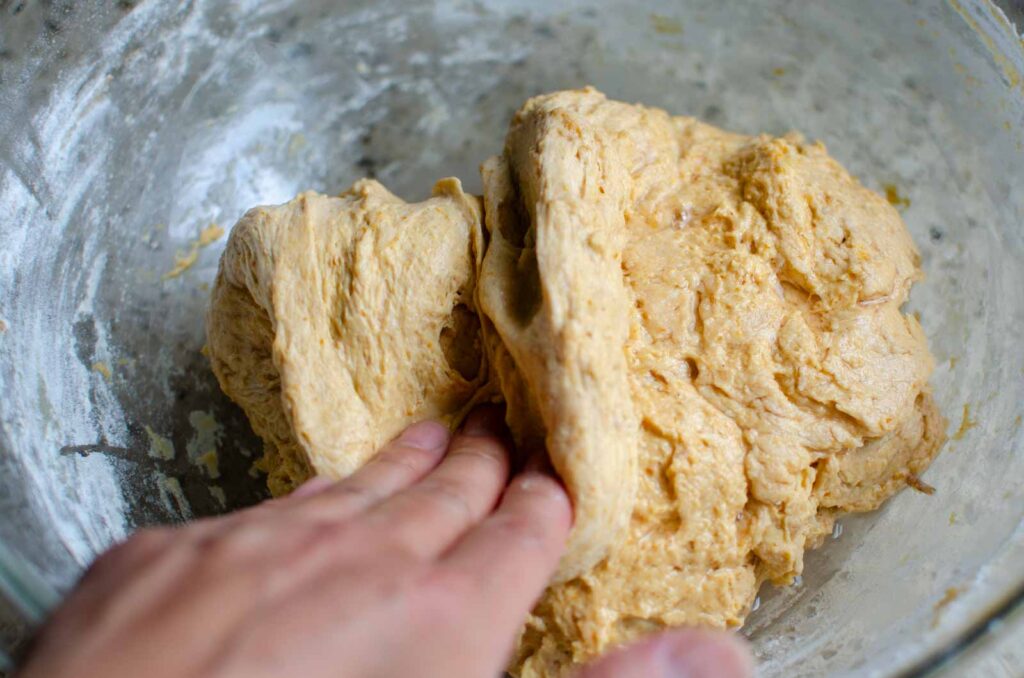
Bulk Ferment or First Proof
Cover the bowl and place it in a warm place in the kitchen for 8-12 hours or until the dough has doubled its starting size. The exact amount of time it takes for the dough to reach this point will depend on a few variables, but largely on how warm the dough is.
I traditionally do this step overnight. Generally in the winter, I will mix my dough right after dinner, but in the summer I will wait until an hour and a half before I head to bed to shorten the bulk ferment time.
This resting time gives the bacteria and yeast in the dough a chance to ferment the grains and develop the dough’s flavor and structure.
Shape
The next morning, roughly chop 60 g (3/4 cup) pecans and combine them with 1 tbsp cinnamon and 1/2 tsp nutmeg in a small bowl.
Next, turn the dough out onto the counter dusted with a little bit of flour. Gently stretch the sides of the dough into a round shape.
Sprinkle half of the pecans over the dough. Fold the top of the dough 2/3 of the way down and sprinkle with half of the remaining pecan mixture. Then, fold the bottom of the dough up to cover the folded portion and add the remaining pecans over the dough.

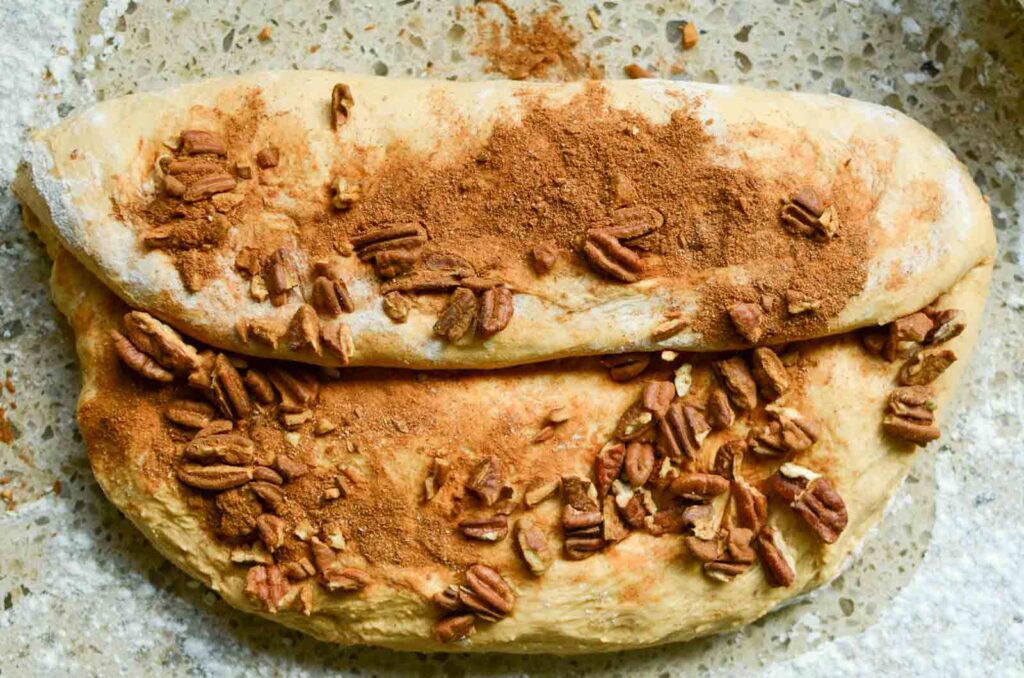
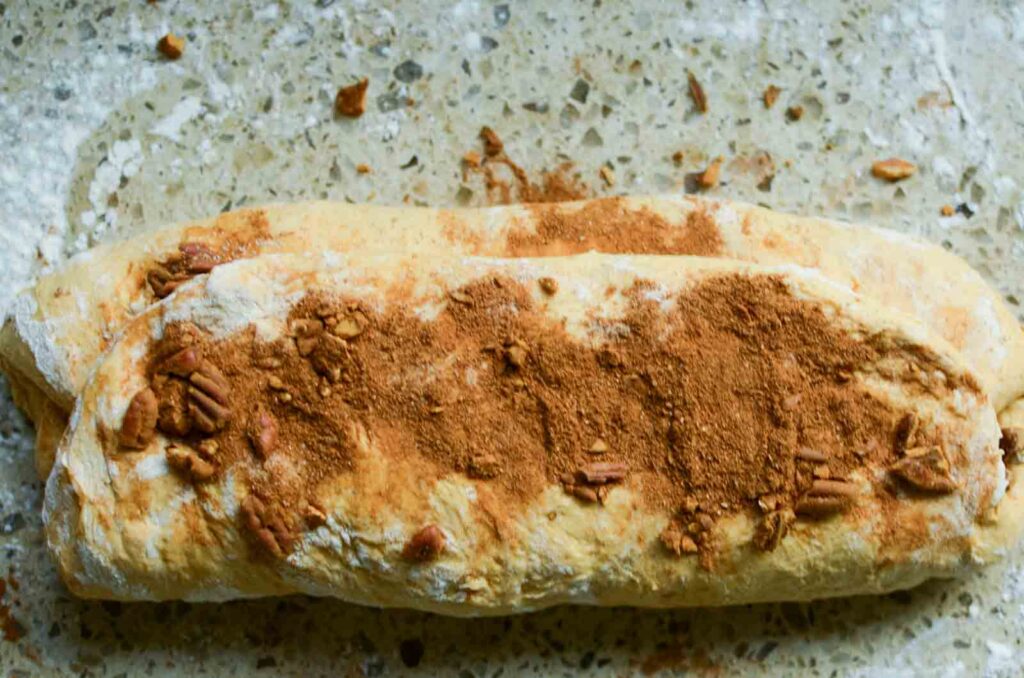
Starting at one end of the dough, roll up the dough. Position the dough so that the seams are facing downward.
Cupping your hands on the far end of the dough, gently pull it towards you, pressing it under as you pull it. This stretches the top of the dough to create some surface tension, which helps with oven spring and a taller loaf.
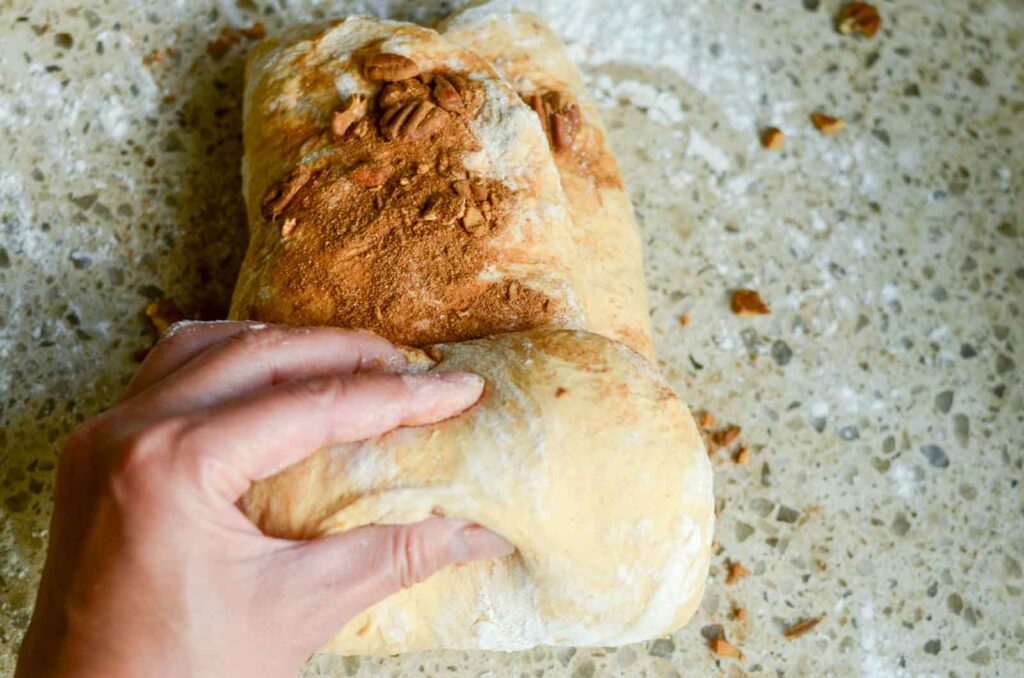
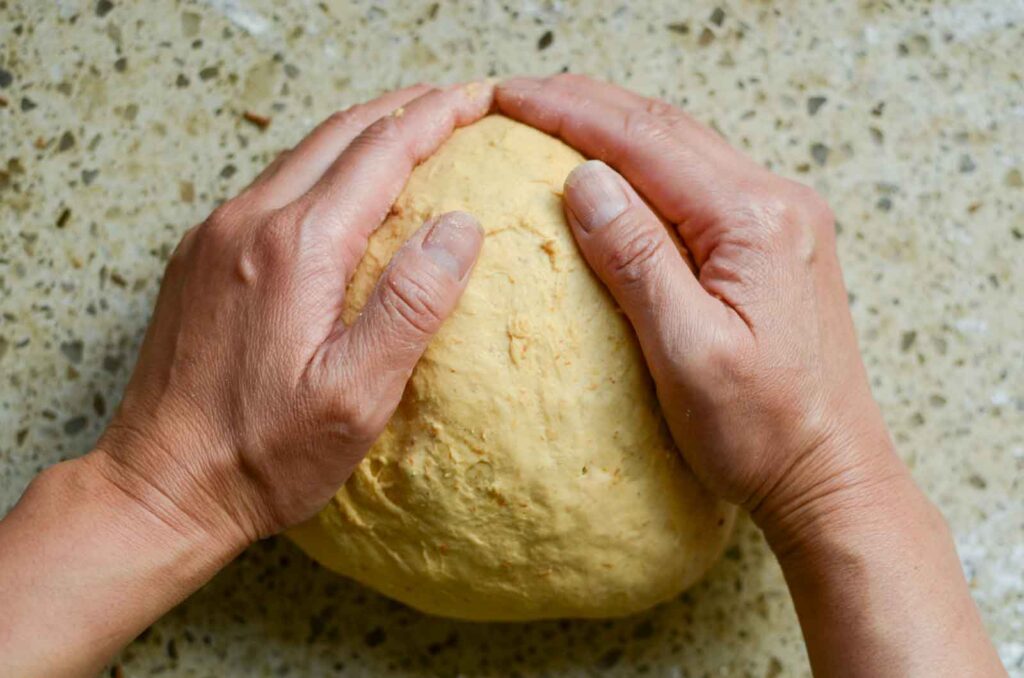
Using a bench knife, lift the dough with into a parchment-lined bowl, bottom side down, or a floured banneton basket, bottom side up and cover.
Final Proof
Let the dough rest in the bowl or banneton to proof for one to three hours. The exact time will depend on the temperature of your kitchen. The dough will have risen a bit and look puffy. You may or may not see tiny pockets of air in the dough. The dough is ready to bake when it passes the finger poke test. (See below for more info)
Retarding The Dough (Optional)
Cold proofing, also known as retarding the dough, is when the dough is placed into the refrigerator to proof at a cold temperature for many hours, typically overnight.
Cover the bowl with a piece of plastic wrap or a plate or cutting board. If you are using a banneton, place it into a plastic bag to keep the dough from drying out. Place the dough into the fridge for as little as 4 hours, up to 16 hours.
Keep in mind that the dough will continue to proof in the fridge, although at a slower rate.
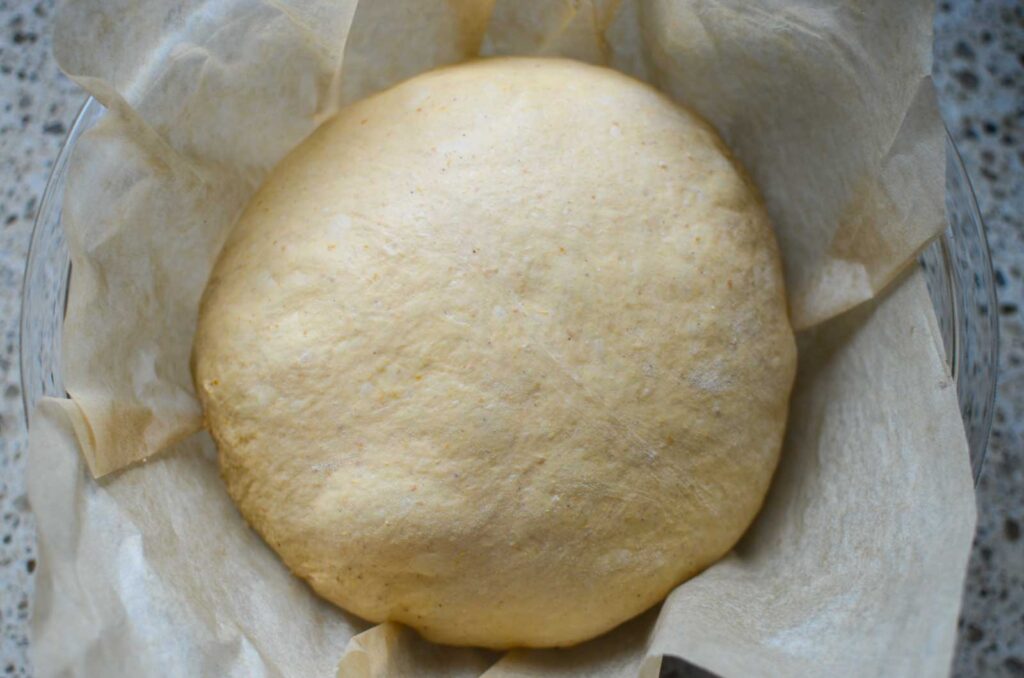
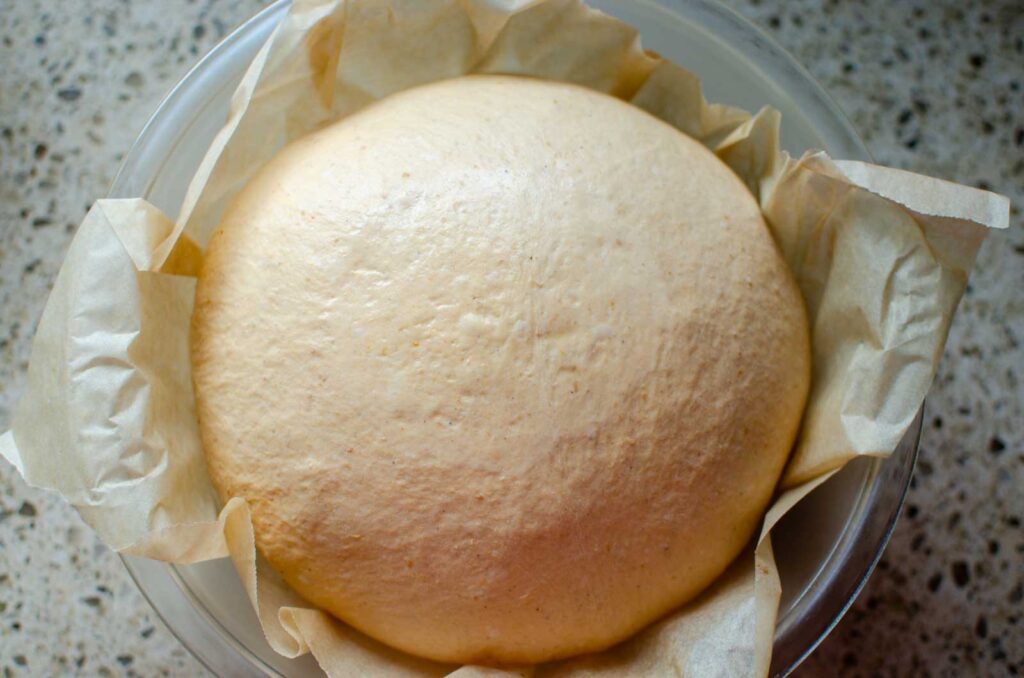
Bake
When you’re ready to bake, preheat a Dutch oven at 450 degrees for 30 minutes.
Remove the dough from the fridge and score the top of the dough with a lame or sharp knife. Lift the pumpkin dough into the hot Dutch oven. Replace the lid quickly and return the Dutch oven to the oven. Bake for 35 minutes. Remove the lid and bake for another 25 minutes.
The bread is done when the top of the loaf is golden brown and the internal temperature reads 200 degrees on a digital thermometer.
Cool
Transfer the bread from the Dutch oven to a wire rack and allow to cool to room temperature before slicing.
How To Store Pumpkin Sourdough Bread
Allow the bread to cool completely before moving to an airtight container. Store at room temperature up to 3 days for best flavor.
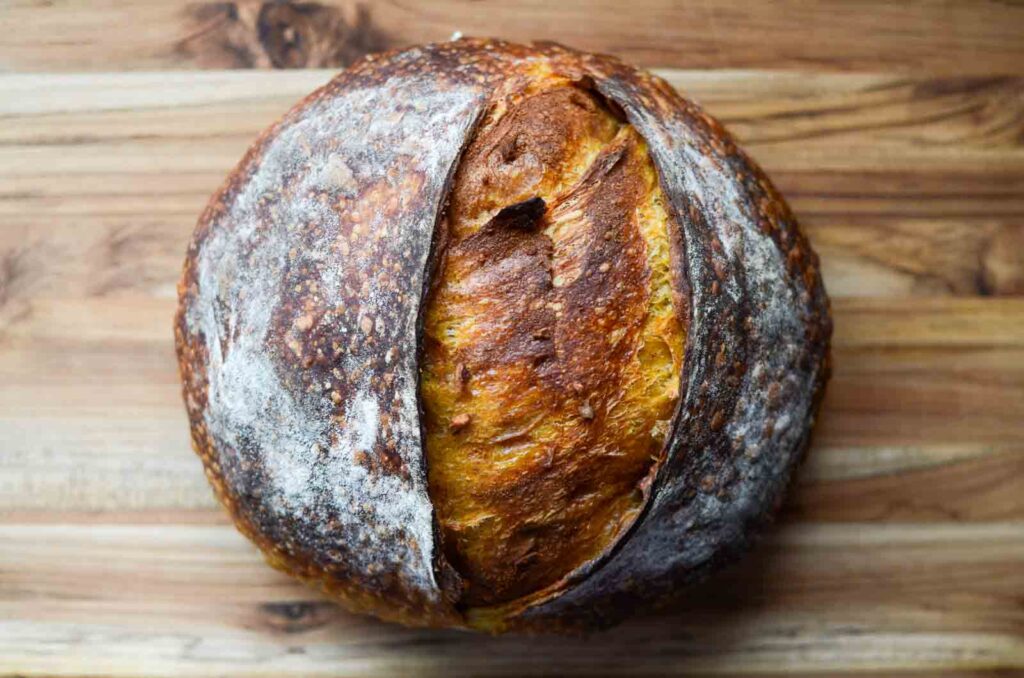
FAQs
Can I Skip Retarding The Dough?
Yes, you can skip this step and move right to baking the bread after its final proof. However, retarding the dough does a couple of things to improve the bread.
First, cold bread dough is easier to score. This step will be helpful if you want a bread loaf with a beautiful scored design.
Second, retarding the dough creates a more complex flavor in the final bake. The extended time allows the bacteria to continue to grow while slowing the rate of the yeast. All of this results in a lovely tasting bread.
Lastly, cold-proofing the dough results in a high chance for the crust to blister as seen in the photo above. The extended time to proof allows little pockets of carbon dioxide to rise to the surface. The high heat captures these to create the blistered skin. While we enjoy this look stateside, other parts of the world look down upon it.
How Do I Make My Sourdough Pumpkin And Pecan Bread Taste More Sour?
Bread dough that is allowed to proof at room temperature is ready to bake in a shorter amount of time than bread dough allowed to retard in the fridge. If you want that distinct sourdough flavor, you will need to extend the time before the bread dough goes into the oven. Cooling the temperature of the bread dough buys you this time without the dough over proofing.
So if you want that classic sourdough tang be sure to retard the dough for an extended length of time. If you enjoy the benefits of sourdough without the tang then shorten the retarding stage, or skip it all together.
What Is The Finger Poke Test?
In the most basic terms, you poke the bread dough with a floured finger to determine whether the dough is ready to bake or if it needs more time to proof. It’s simple, free, and easy to master once you know what to look for.
When the dough is proofing, poke the dough with a floured finger about 1/2 inch deep and quickly remove. If the dough bounces back and fills the indentation quickly and completely, then the dough needs more time to proof. If the dough doesn’t bounce back at all, then it’s over proofed. There’s not too much to do at this point other than to continue with the bake.
There is a sweet spot between these two extremes when the dough bounces back a bit, but without completely filling in the gap. This is what you’re looking for.
Recognizing what the dough looks like with the poke test comes with practice. The more that you do the poke test and see the final results in your bread, the more you will come to understand the process. So don’t be discouraged if you don’t get it quite right the first few times, just keep baking and practicing.
Why Do I Need To Wait To Slice The Bread?
While it’s tempting to slice into the bread before it’s cool, the loaf of bread needs this cool-down time to retain its moisture. Once you slice into a warm loaf of bread, the steam rushes out all at once, resulting in a drier loaf of bread.
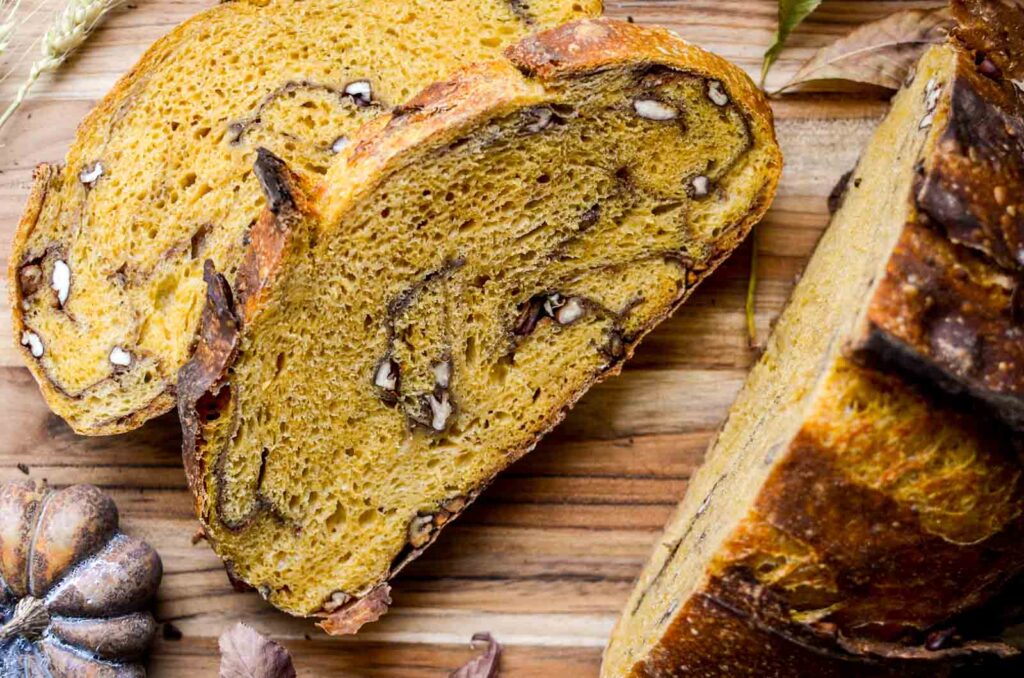
Sample Schedule
Day 1
8 pm – mix the dough
8:30 pm – add salt water and perform first set of stretch and folds
9:00 pm – second set of stretch and folds
9:30 pm – third set of stretch and folds
9:30 pm – 7:30 am – bulk ferment
Day 2
7:30 am – shape bread dough and place in banneton or bowl
7:45 am – 9 am – proof at room temperature
9:00 am – 1 pm – retard dough in refrigerator
1:00 pm – preheat Dutch oven to 450 degrees
1:30 pm – score dough and bake the bread
I’d love to hear from you! Please leave a comment and rate the recipe. Tag photos #Lockremhomestead over on Instagram when you share pictures of your Artisan Sourdough Pumpkin and Pecan Bread!
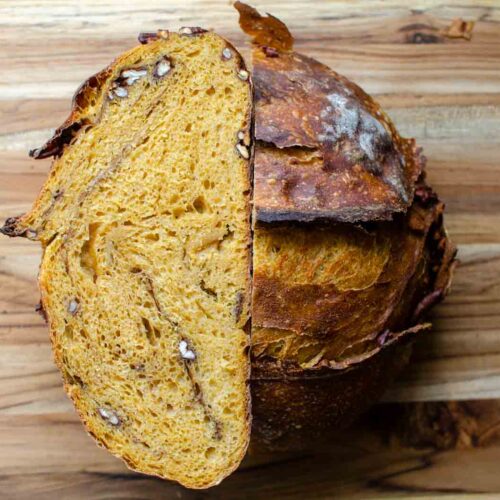
Artisan Sourdough Pumpkin and Pecan Bread
Want to Save This Recipe?
Enter your email & I’ll send it to your inbox. Plus, get great new recipes from me every week!
By submitting this form, you consent to receive emails from Lockrem Homestead
Equipment
- 1 Dutch Oven
- 1 large bowl
- 1 banneton
- 1 lame or sharp knife
Ingredients
Wet Ingredients
- 125 g active sourdough starter ½ cup
- 250 g pumpkin puree 2¼ cups
- 150 g warm water ⅔ cup
- 40 g maple syrup 2 tbsp
Dry Ingredients
- 500 g bread flour 4 cups
- ½ tsp cinnamon
Salt Water
- 36 g warm water 3 tbsp
- 10 g salt 2 tsp
Pecan Swirl
- 60 g pecans ¾ cup
- 1 tbsp cinnamon
- ½ tsp nutmeg
Instructions
Mix The Dough
- Combine 125 g (1/2 cup) active sourdough starter, 250 g (2 1/4 cups) pumpkin puree, 150 g (2/3 cup) warm water, and 40 g (2 tbsp) maple syrup in a large bowl.
- Then, add 500 g (4 cups) bread flour and combine it with a dough whisk, making sure to mix the flour at the bottom of the bowl. Cover and let rest for 30 minutes. This allows the flour time to absorb the water.
- After 30 minutes, combine 36 g (3 tbsp) water and 10 g (2 tsp) salt in a small bowl, stirring until the salt dissolves. Pour the salty water over the bread dough and mix it in using the stretch and folds method.
Stretch And Folds
- Grab the sides of the dough and lift straight up, stretching the dough. Then fold it over onto itself, pressing it into the middle of the dough.
- Let the dough rest for 30 minutes. This completes one set of stretch and folds.
- Do a total of 3 sets of stretch and folds at 30-minute intervals. You'll notice the dough change from a shaggy, sticky dough that breaks easily as you stretch it, to a smooth, elastic dough with much less stickiness by the last fold.
Bulk Ferment or First Proof
- Cover the bowl and place it in a warm place in the kitchen for 8-12 hours or until the dough is double its starting size. The exact amount of time it takes for the dough to reach this point will depend on a few variables, but largely on how warm the dough is.
Shape
- The next morning, roughly chop 60 g (3/4 cup) pecans and combine them with 1 tbsp cinnamon and 1/2 tsp nutmeg in a small bowl.
- Next, turn the dough out onto the counter dusted with a little bit of flour. Gently stretch the sides of the dough into a round shape.
- Sprinkle half of the pecans over the dough. Fold the top of the dough 2/3 of the way down and sprinkle with half of the pecan mixture. Then, fold the bottom of the dough up to cover the folded portion and add the remaining pecans over the dough.
- Starting at one end of the dough, roll up the dough. Position the dough so that the seams are facing downward.
- Cupping your hands on the far end of the dough, gently pull it towards you, pressing it under as you pull it. This stretches the top of the dough to create some surface tension, which helps with oven spring and a taller loaf.
- Using a bench knife, lift the dough with into a parchment-lined bowl, bottom side down, or a floured banneton basket, bottom side up and cover.
Final Proof
- Let the dough rest in the bowl or banneton for one to three hours to proof, depending on the temperature of your kitchen. The dough will have risen a bit and look puffy. You may or may not see tiny pockets of air in the dough. The dough is ready to bake when it passes the finger poke test.
Retarding The Dough (Optional)
- Cover the bowl with a piece of plastic wrap or a plate or cutting board. If you are using a banneton, place it into a plastic bag to keep the dough from drying out.
- Place the dough into the fridge for as little as 4 hours, up to 16 hours.
Bake
- When you're ready to bake, preheat a Dutch oven at 450 degrees for 30 minutes.
- Remove the dough from the fridge, score the top of the dough with a lame or sharp knife, and place it into the hot Dutch oven. Quickly replace the lid and return the Dutch oven to the oven. Bake for 35 minutes. Remove the lid and bake for another 25 minutes.
- The bread is done when the top of the loaf is golden brown and the internal temperature reads 200 degrees.
Cool
- Transfer the bread from the Dutch oven to a wire rack and allow to cool to room temperature before slicing.

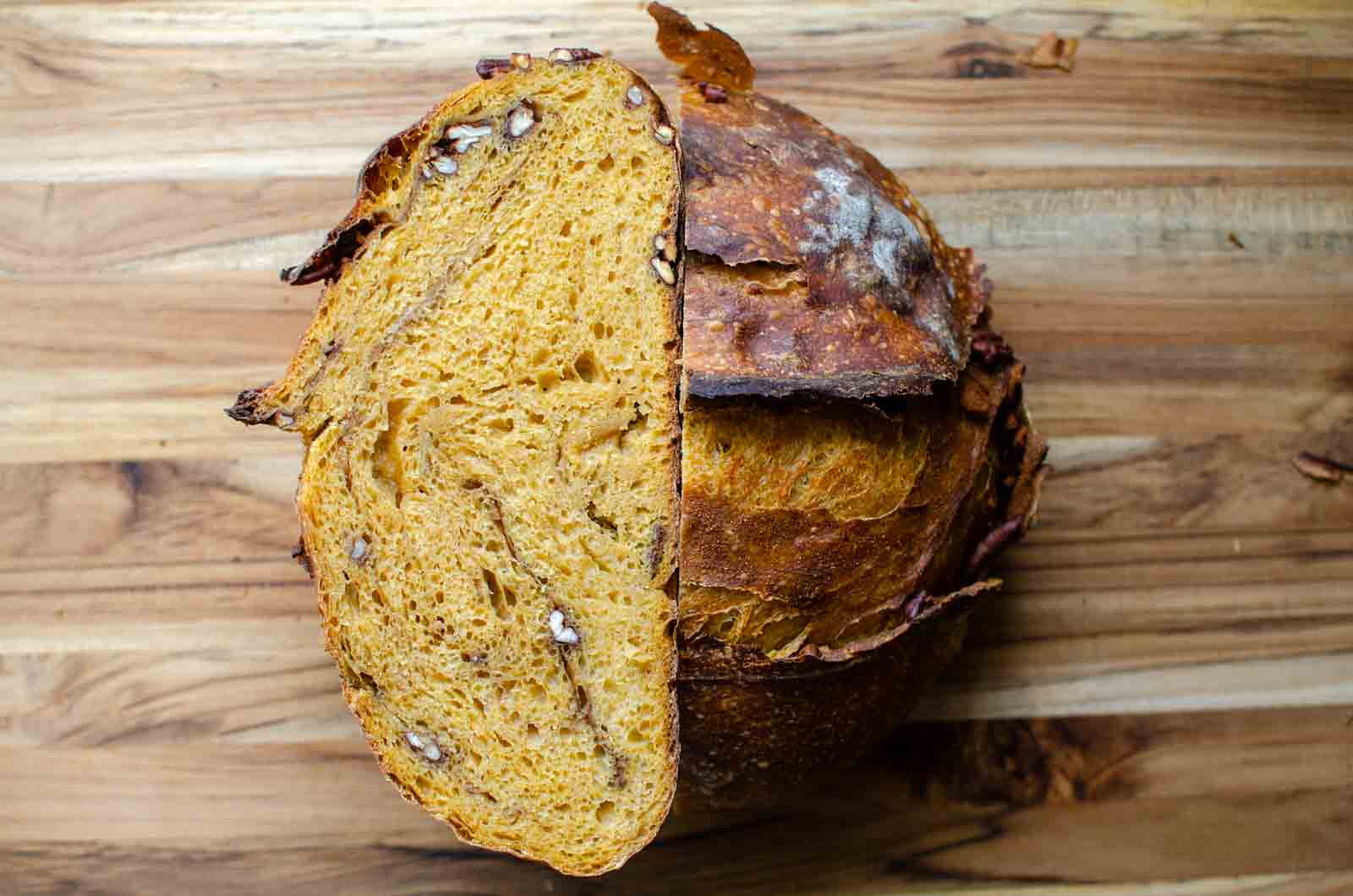

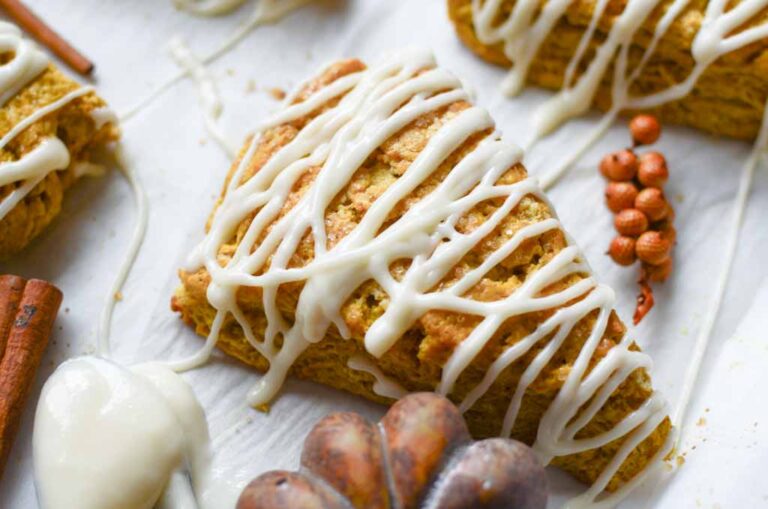
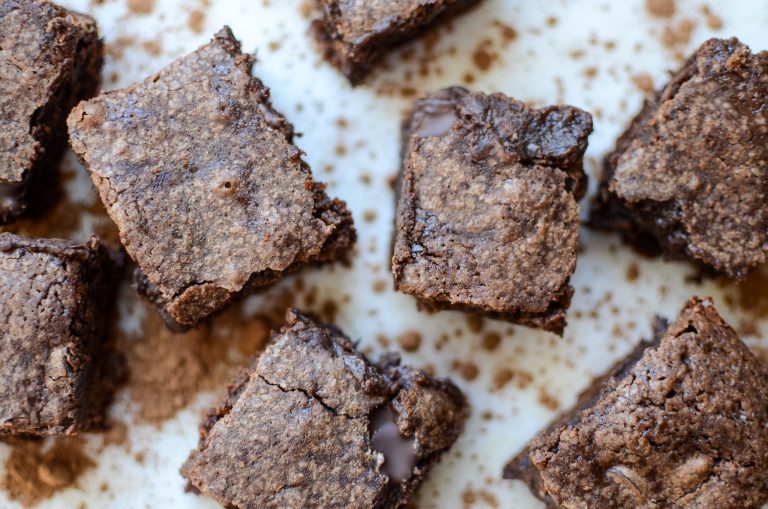

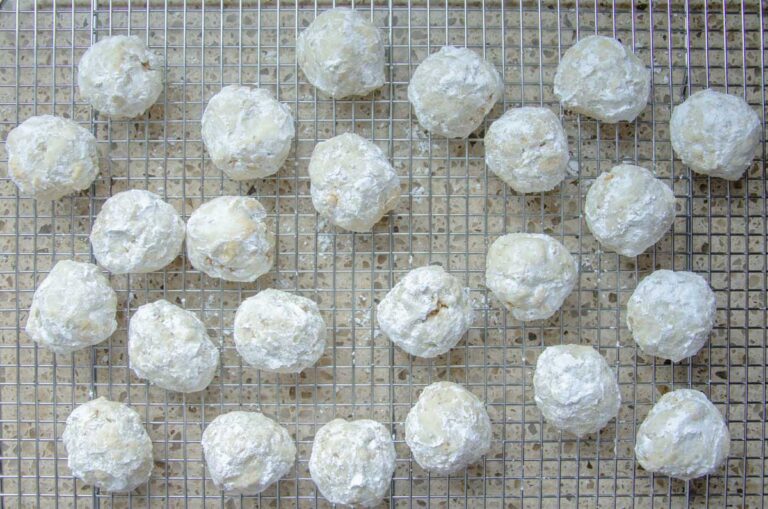
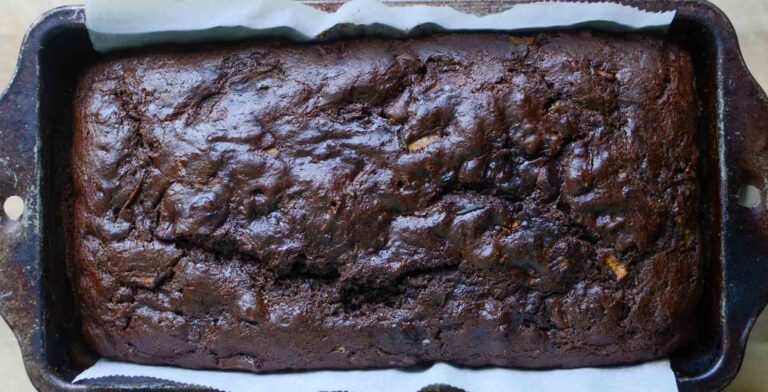
I know you’re going to LOVE this recipe! It’s one of our family favorites. Plus, don’t forget that you can leave a comment or ask me a question here, and I’ll get back to you!